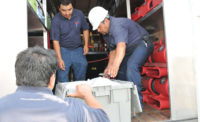
There are a number of different types of personal protective equipment (PPE) useful for worker protection. Occupational Safety and Health requirements state that employers must provide protection against recognized hazards that can result in serious physical harm or death. In some states the requirements may be stricter; for example, California says that employers must provide safe and healthful work environments.
Some work place hazards, such as the use of chemicals, have PPE requirements that are easy to determine based on manufacturers specifications and Material Safety Data Sheets (MSDS). These documents are prepared by the manufacturer and must identify hazards and require specific appropriate types and levels of PPE for safe use of the product. When it comes to mold remediation the EPA states in Mold Remediation in Schools and Commercial Buildings that “Standards or Threshold Limit Values (TLVs) for airborne concentrations of mold, or mold spores, have not been set...there are no EPA regulations or standards for airborne mold contaminants.” Nonetheless, mold remediation workers still require protection.
Decisions regarding the use of gloves, disposable suits that are impermeable to mold spores, head covers, shoe covers, eye protection and hearing protection are usually easy to make. The appropriate respiratory protection is often times not so clear cut.
Employers need to use criteria other than MSDS sheets, TLVs and permissible exposure limits when protecting their employees against respiratory hazards when specific regulations are absent. The ANSI/IICRC S520 Standard and Reference Guide for Professional Mold Remediation does not spell out the specific PPE to use. Instead it states:
“When it has been determined that an indoor environment is contaminated with mold, remediation workers shall be protected from exposure. Engineering controls and work practices are the primary means for preventing exposure. Appropriate respiratory protection or other personal protective equipment (PPE) shall be used in conjunction with engineering controls to protect workers when engineering controls are insufficient.” (S520 4.1)
“Employers shall provide dermal and respiratory protection for employees entering a containment area where microbial contamination is present and remediation is being performed. The selection of PPE depends on the anticipated exposure, types of microbial contamination, activities to be completed and potential hazards of chemicals that may be used in the remediation process.” (S520 8.3.2)

The P-100 filter is an appropriate choice since it provides HEPA filtration efficiencies; however, the effectiveness of the filter has nothing to do with the effectiveness of the respirator and the protection it provides. This is because respirator performance is rated according to how well the respirator seals to the face. It doesn’t matter how well the filters filter if the respirator doesn’t fit and seal tightly against the skin.
My goal here is not to argue with New York City regarding the level of personal protection used for building maintenance staff, but to address this issue for professional remediation technicians. It is my opinion the levels of personal protection suggested in the New York City Guidelines are inadequate for the professional mold remediator.
The EPA in Mold Remediation in Schools and Commercial Buildings, states: “In situations in which high levels of airborne dust or mold spores are likely or when intense or long-term exposures are expected (e.g., the clean-up of large areas of contamination), a full-faced powered air purifying respirator (PAPR) is recommended.”

An N-95 disposable face-piece respirator reduces particles entering the workers breathing zone five-fold. The half-face respirator reduces particles tenfold. If we consider that exposure to mold during remediation activities can be 10 to 1,000 times the normal background rate it becomes apparent that the N-95 with a Protection Factor of five and the half-face respirator with an Assigned Protection Factor (APF) of 10 would be inadequate for providing protection for remediation workers against any significant exposures during remediation activities.
A full-faced Air Purifying Respirator does a much better job of sealing to the face. It has an APF of 50 and may be appropriate when proper engineering controls are also used for reducing worker exposure during the remediation. Powered Air Purifying Respirators when properly used may have a Protection Factor as high as 1,000 and can significantly reduce mold spore and particulate exposure when used with the appropriate filter cartridge. Another advantage of both the full-faced respirator and the PAPR are they have built in face-pieces which help protect the employee’s face and eyes from flying debris.
Remediation workers are exposed to the fungal fragments and spores at higher levels for longer periods of time. Based on this, they at least need a full-faced respirator in order to help protect the workers and satisfy OSHA requirements under the General Duty Clause.


Report Abusive Comment